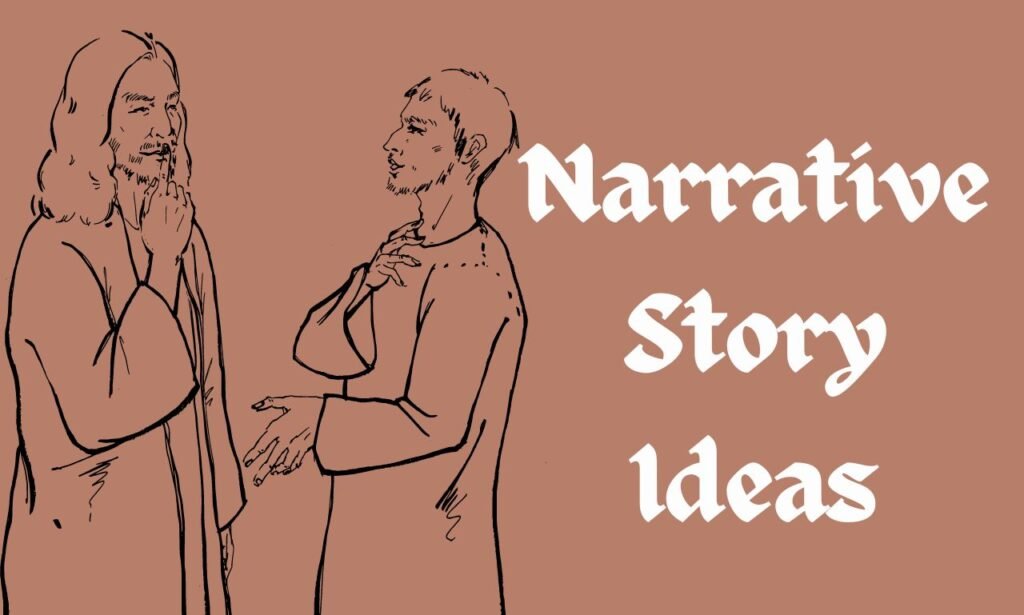How to get narrative story ideas in 2024 is very important to write sparking and emotion-awaking stories. If you are still looking for inspiration, don’t worry as we have you. The article below is the ultimate guide for you to get narrative story ideas and write perfect content for your audience.
Narrative storytelling is a timeless craft that weaves threads of imagination, emotion, and experience into captivating tales. Yet, for many, the journey from a fleeting idea to a fully-fledged narrative can feel like navigating uncharted waters.
Let’s delve deep into the details and understand more about how to get narrative story ideas in 2024.
What is a Narrative Story:
A narrative story is a compelling form of expression that immerses audiences in a crafted world of characters, settings, and events. It serves as a vessel for conveying experiences, emotions, and messages, often unfolding through a structured plot with identifiable elements like conflict, resolution, and character development.
Whether fiction, non-fiction, or personal, narratives captivate through their ability to transport readers or listeners, evoke empathy, and provoke thought. Essentially, a narrative story is a journey, inviting individuals to engage with its intricacies, empathize with its characters, and reflect on its themes long after the tale concludes.
Elements of Narrative Story:
Character:
Characters are the heart of narrative storytelling, embodying the essence of the plot. They possess distinct traits, motivations, and arcs that propel the story forward and deeply engage audiences. Protagonists, antagonists, and supporting cast alike contribute to the narrative’s richness, each with their own complexities. Through their actions, dialogue, and interactions, characters breathe life into the story, leaving a lasting impression on readers.
Setting:
Setting establishes the backdrop against which a narrative unfolds, encompassing the time, place, and atmosphere of the story. It serves as more than just a physical backdrop; it can also influence mood, tone, and character behavior. Whether a bustling cityscape, a tranquil countryside, or a distant galaxy, a well-crafted setting enriches the narrative, immersing readers in its world and enhancing the overall storytelling experience.
Plot:
The plot drives the narrative forward, weaving together events and conflicts that propel the story towards its resolution. It unfolds organically, revealing twists and turns that keep readers engaged. Every action and consequence contributes to the plot’s development, building tension and suspense. Through its structure and pacing, the plot captivates audiences, inviting them to journey alongside the characters as they navigate challenges and overcome obstacles on their path to fulfillment.
Conflict:
Conflict, an essential element of narrative storytelling, drives the plot forward and creates tension that keeps readers engaged. It arises from opposing forces or obstacles faced by the protagonist, propelling them towards resolution or transformation. Whether internal struggles, interpersonal conflicts, or external challenges, conflict injects vitality into the narrative, fueling character development and thematic exploration. In its resolution lies the heart of the story, offering insights and catharsis for both characters and audience alike.
Theme:
In narrative storytelling, a theme embodies the underlying message or central idea conveyed. It guides character arcs, plot developments, and reader interpretation. Themes explore universal truths, societal issues, or personal growth, resonating with audiences on multiple levels. Whether love, loss, redemption, or resilience, themes add depth and resonance to the narrative, inviting readers to reflect and connect with the story’s essence.
Types of Narrative Stories:

Fictional Stories:
Fictional stories are the cornerstone of imaginative exploration, transporting audiences to worlds crafted entirely from the author’s creativity. Within these narratives, characters, settings, and events exist beyond the confines of reality, allowing for boundless creativity and invention. Whether exploring fantastical realms, futuristic dystopias, or historical epochs, fictional stories captivate readers with their ability to ignite the imagination and challenge perceptions of what is possible. Through intricate plots, rich world-building, and vivid prose, fictional stories offer escapism, entertainment, and profound insights into the human experience.
Non-fictional Stories:
Non-fictional stories are rooted in the tangible realities of our world, offering accounts of real-life events, experiences, and phenomena. From journalistic exposés to intimate memoirs, these narratives draw from factual evidence, research, and firsthand accounts to inform, educate, or entertain readers. Non-fictional stories span a diverse array of genres, including biography, history, science, and travelogue, each providing unique perspectives on the complexities and nuances of human existence. Grounded in truth, non-fictional stories offer opportunities for learning, enlightenment, and a deeper understanding of the world around us.
Personal Narrative Stories:
Personal narrative stories offer intimate glimpses into the lives, experiences, and emotions of the authors themselves. These deeply personal accounts draw from the author’s own memories, reflections, and observations, inviting readers into the innermost depths of their hearts and minds. From coming-of-age tales to transformative life journeys, personal narrative stories explore themes of identity, resilience, love, and loss with raw honesty and emotional depth. Through the power of storytelling, authors forge connections with readers, fostering empathy, understanding, and shared humanity amidst the intricacies of the human experience.
How To Get Narrative Stories Ideas in 2024:
Here are the most popular and tested techniques on how to get narrative story ideas in 2024 and write engaging content for your readers.
Brainstorming:
brainstorming is the most widely used method to get narrative story ideas. Engage in freewriting sessions, jotting down any thoughts or prompts that come to mind. Explore personal experiences, dreams, or intriguing news stories. Consider what-if scenarios or unusual perspectives. Use visual aids like mind maps or storyboards to organize ideas. Additionally, draw inspiration from literature, movies, or historical events. Collaborate with others for diverse perspectives. Lastly, immerse yourself in different environments or cultures to spark creativity. Remember, the key is to be open-minded and willing to explore various avenues for inspiration.
Freewriting:
To generate narrative story ideas, try freewriting. Start with a blank page and let your thoughts flow without worrying about grammar or coherence. Set a timer for a few minutes and write down whatever comes to mind. Don’t censor yourself; allow spontaneity to guide you. Explore memories, observations, or hypothetical scenarios. Embrace randomness and unexpected connections. After your freewriting session, review your notes. You may find hidden gems or themes worth exploring further. Freewriting can unlock creativity and lead to unique narrative story ideas ripe for development.
Mind Mapping:
To generate narrative story ideas effectively, employ mind mapping. Begin with a central theme or concept and branch out with related subtopics. Use keywords, images, or short phrases to represent each idea. Explore connections between different branches, allowing for creative associations. Engage in free-flow thinking without judgment to encourage diverse ideas. Consider personal experiences, observations, or even prompts for inspiration. Utilize color-coding or different shapes to distinguish between various elements. Regularly revisit and refine your mind map to develop and expand upon promising story concepts. Mind mapping is a versatile tool for stimulating creativity and generating narrative ideas.
Listing:
To generate narrative story ideas effectively, begin by exploring various prompts and themes. Dive into personal experiences, dreams, or even news headlines for inspiration. Engage in brainstorming sessions, jotting down every thought, no matter how small. Consider prompts like “what if” scenarios or character-driven questions. Delve into history or folklore for intriguing plotlines. Utilize writing exercises such as free writing or mind mapping to stimulate creativity. Collaborate with others for fresh perspectives. Ultimately, the key lies in keeping an open mind and allowing ideas to flow naturally.
Personal Experiences and Observations:
explore personal experiences and observations to craft compelling narratives. Reflect on moments that evoke emotion or curiosity. Consider interactions, places visited, or challenges faced. Dive into memories that reveal insights or stir feelings. Pay attention to details and nuances that make experiences unique. From everyday occurrences to extraordinary events, mine the richness of life for storytelling material. Capture the essence of your journey through authentic storytelling, drawing readers into your world with vivid imagery and relatable anecdotes.
Research and Reading:
To gather narrative story ideas, engage in research and reading. Dive into various sources such as books, articles, and online content. Explore topics that intrigue you or align with your interests. Delve into historical accounts, scientific discoveries, or cultural phenomena. Take notes on compelling narratives, intriguing characters, or fascinating plot twists. Analyze storytelling techniques and narrative structures to inspire your own creations. Absorb knowledge from diverse perspectives and disciplines. By immersing yourself in research and reading, you’ll enrich your imagination and uncover a wealth of story ideas to explore further.
Analyzing Existing Elements:
To analyze existing elements for narrative story ideas, examine various sources like books, movies, or news articles. Identify compelling characters, intriguing settings, or thought-provoking themes. Dissect plot structures, conflicts, and resolutions. Consider how you can reimagine or reinterpret these elements to create original narratives. Look for gaps or unanswered questions that could serve as launching points for exploration. Incorporate your unique perspective and voice into the analysis. By deconstructing existing stories, you can uncover inspiration and develop fresh ideas that resonate with your audience.
Tips To Write a Perfect Narrative Story:
Here are a few expert tips for you on writing perfect narrative stories.
- Start with a captivating hook to grab readers’ attention from the outset.
- Develop well-rounded characters with depth, flaws, and aspirations.
- Build tension through conflicts that challenge your characters’ beliefs and values.
- Use vivid descriptions to immerse readers in the story’s setting and atmosphere.
- Maintain a clear narrative arc with a beginning, middle, and satisfying resolution.
- Show, don’t tell, engage readers by letting actions and dialogue reveal emotions and motivations.
- Leave room for interpretation and reflection, allowing readers to connect with the story on a personal level.
How To Get Narrative Story Ideas in 2024: Other Methods
Stay Updated:
Staying abreast of current events, technological innovations, and societal shifts is imperative for writers seeking narrative inspiration in 2024. By actively monitoring trends and developments across various domains, writers can identify timely topics and themes to explore in their narratives. Whether it’s advancements in artificial intelligence, shifts in cultural attitudes, or global socio-political movements, keeping a finger on the pulse ensures that narratives remain relevant and resonate with contemporary audiences.
Engage with Diverse Perspectives:
Engaging with diverse viewpoints and voices is essential for enriching narrative storytelling. Through active participation in online communities, forums, and social media platforms, writers gain invaluable insights into a myriad of experiences, perspectives, and narratives. By immersing themselves in the stories and perspectives of others, writers can foster empathy, authenticity, and inclusivity in their storytelling, creating narratives that resonate deeply with audiences from diverse backgrounds and walks of life.
Reflect on Personal Experiences:
Personal experiences serve as a rich source of inspiration for narrative storytelling. By reflecting on their own life journey, challenges, triumphs, and moments of personal growth, writers can infuse authenticity, depth, and emotional resonance into their narratives. Exploring the intersection between personal experiences and broader societal themes allows writers to tap into universal human experiences, creating narratives that are not only deeply personal but also universally relatable and impactful.
Emerging Latest Technologies:
In addition to traditional sources of inspiration, writers can explore unconventional avenues for narrative ideas in 2024. Speculative fiction offers endless opportunities to imagine future scenarios based on current trends, technological advancements, and societal changes. Science fiction allows writers to explore the potential implications of emerging technologies on humanity and society, offering thought-provoking narratives that challenge and inspire. Reinterpreting classic narratives through a contemporary lens offers a fresh perspective on timeless themes, providing fertile ground for creative exploration and reinvention.
Conclusion: How To Get Narrative Story Ideas in 2024
How to get narrative story ideas in 2024 is the most common problem of newbies and even experienced writers. Crafting a perfect narrative story in 2024 involves weaving together various elements to create a compelling and immersive experience for readers. The opening hook and the final resolution play crucial roles in engaging and captivating the audience.
Developing well-rounded characters, intricate plotlines, and evocative settings transport readers to new worlds, evoking powerful emotions. Remembering to show rather than tell, maintaining a clear narrative arc, and leaving room for interpretation are key principles to master.
FAQs: How To Get Narrative Story Ideas in 2024
What are some best topics for narrative stories?
Personal experiences, overcoming challenges, life-changing moments, historical events, folklore, imaginative scenarios.
How can I write a narrative story?
Start with a hook, develop characters with conflicts, create a plot with a beginning, middle, and end, use descriptive language, and revise for coherence.
What does narrative writing style mean?
It’s storytelling where the author narrates events, focusing on character development, vivid descriptions, and a coherent plot.
What are some other ways how to get narrative story ideas in 2024?
Stay updated on current events, technological advancements, and societal changes. Explore emerging trends and controversial topics. Engage with diverse perspectives online and reflect on personal experiences in the evolving world.

